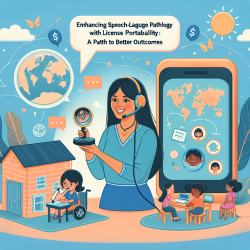Introduction
In the quest to optimize speech therapy outcomes for children, understanding genetic influences on language and communication disorders is crucial. The study titled "Population-genetic comparison of the Sorbian isolate population in Germany with the German KORA population using genome-wide SNP arrays" provides valuable insights that can be leveraged by speech-language pathologists to enhance therapeutic strategies.
Understanding the Research
The research focuses on comparing the genetic makeup of the Sorbian population, an ethnic minority in Germany, with the German KORA population. Using genome-wide SNP arrays, the study identifies significant genetic differences between these populations. The Sorbs exhibit higher degrees of genetic isolation, which is reflected in their unique genetic markers.
Key findings include:
- Higher relatedness within the Sorbian population compared to the KORA group.
- A greater number of rare SNPs in the Sorbian sample, indicating genetic isolation.
- Distinct linkage disequilibrium patterns that suggest moderate genetic isolation.
Implications for Speech-Language Pathology
These genetic insights can be instrumental in tailoring speech therapy interventions. Here’s how practitioners can utilize this information:
- Customized Intervention Plans: Understanding genetic predispositions can help in designing personalized therapy plans that address specific needs based on genetic profiles.
- Early Identification: Genetic markers can be used to identify children at risk of language and communication disorders early, allowing for timely intervention.
- Research and Development: Encourage further research into the genetic basis of speech and language disorders, potentially leading to breakthroughs in therapeutic techniques.
Encouraging Further Research
While this study provides a foundational understanding, there is a need for further research to explore the direct implications of these genetic differences on speech and language development. Practitioners are encouraged to collaborate with geneticists to explore these avenues.
Conclusion
The integration of genetic research into speech therapy practices holds the promise of significantly improving outcomes for children. By understanding the genetic underpinnings of language disorders, speech-language pathologists can make data-driven decisions that enhance the effectiveness of their interventions.
To read the original research paper, please follow this link: Population-genetic comparison of the Sorbian isolate population in Germany with the German KORA population using genome-wide SNP arrays.










